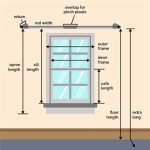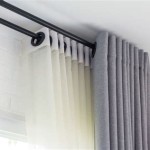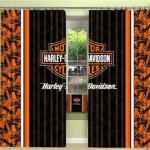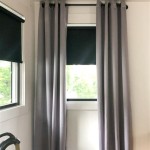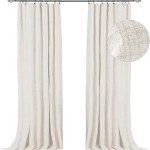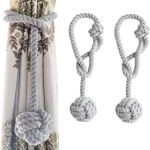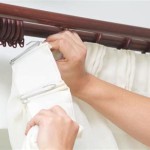Curtains To Keep Out Cold: A Comprehensive Guide
As winter approaches, maintaining a comfortable and energy-efficient home becomes a priority. Drafts can significantly impact indoor temperatures, leading to increased heating costs and reduced comfort levels. One often-overlooked solution for mitigating heat loss through windows is the strategic use of curtains. Selecting and properly installing curtains designed to insulate can be a cost-effective way to improve home energy efficiency and create a warmer living environment.
Windows, while providing natural light and views, are also prime areas for heat loss. Single-pane windows, in particular, offer minimal insulation, allowing heat to escape readily during colder months. Even double-pane windows, without proper sealing or insulation, can contribute to significant heat loss. Curtains act as a barrier, trapping a layer of air between the fabric and the window, effectively reducing the transfer of heat to the colder exterior. The effectiveness of curtains in insulating against cold depends on several factors, including the type of fabric, the construction of the curtain, and how it is installed.
Choosing the right curtains for cold weather insulation requires careful consideration. Not all curtains are created equal in terms of their insulating properties. Factors such as fabric density, weave, and the presence of linings all contribute to a curtain's ability to block cold drafts and retain heat. Understanding these factors is crucial for making an informed decision and selecting curtains that will provide optimal insulation for specific needs.
Key Considerations When Selecting Curtains for Insulation
Selecting the appropriate curtains for optimal cold weather insulation involves a multi-faceted approach, considering both material properties and construction features. Understanding these elements can significantly enhance the effectiveness of curtains in reducing heat loss and improving energy efficiency.
Fabric Type and Density: The type of fabric used in curtains plays a significant role in its insulating capabilities. Thicker, denser fabrics generally offer better insulation. Materials like wool, velvet, and heavy-weight cotton are known for their thermal properties. These fabrics have a tight weave that restricts airflow and helps to trap a layer of insulating air between the curtain and the window. Fabrics with a loose weave, such as linen or sheer materials, offer minimal insulation and are not suitable for cold weather applications. The weight of the fabric is also an indicator of its density and, therefore, its insulating potential. Heavier fabrics will generally provide better insulation than lighter ones. When evaluating fabric options, it is important to consider both the type of fiber and the weave density to determine its effectiveness in blocking cold drafts.
Curtain Lining: Adding a lining to curtains significantly enhances their insulating properties. Linings act as an additional barrier against heat loss, further reducing the transfer of cold air into the room. Thermal linings are specifically designed to provide insulation and are often made of materials like acrylic suede or multiple layers of insulating fabric. Blackout linings, while primarily intended to block light, also offer excellent insulation due to their dense construction. When selecting a lining, it is crucial to choose one that is compatible with the main curtain fabric in terms of weight and care requirements. Linings can be attached to the curtains in various ways, including sewn-in linings, detachable linings, or iron-on linings. Sewn-in linings offer the most permanent and seamless integration, while detachable linings provide flexibility for washing and seasonal adjustments.
Curtain Construction and Design: The way a curtain is constructed also impacts its insulating effectiveness. Curtains with pleats or folds create more surface area, which increases the amount of air trapped between the fabric and the window. This trapped air acts as an insulator, preventing cold air from entering the room. Eyelet curtains, while aesthetically pleasing, may allow more airflow at the top, reducing their insulating effectiveness. Similarly, curtains that do not reach the floor or extend beyond the window frame may allow drafts to enter from the sides and bottom. For optimal insulation, curtains should be long enough to reach the floor and wide enough to extend beyond the window frame on both sides. This ensures that the entire window area is covered, minimizing drafts and maximizing heat retention. Consider curtains with features like weighted hems to create a tighter seal against the floor, further preventing drafts.
Installation Techniques for Maximizing Insulation
Proper installation is as important as choosing the right curtains for insulation. Even the most effective curtains will not perform optimally if they are not installed correctly. Paying attention to installation details can significantly enhance the effectiveness of curtains in reducing heat loss and improving home comfort.
Rod Placement: The placement of the curtain rod significantly impacts the curtains' ability to prevent drafts. The rod should be positioned as close to the ceiling as possible. This allows the curtains to cover the entire window area, minimizing heat loss from the top. The rod should also extend beyond the window frame on both sides. This ensures that the curtains block drafts from the sides and prevent light leakage. Using a wider rod allows the curtains to be fully opened without obstructing the window, maximizing natural light when desired. When installing the rod, it is important to use sturdy brackets that can support the weight of the curtains, especially if they are made of heavy fabric or have a lining. Secure the brackets firmly to the wall studs to prevent them from pulling out under the weight of the curtains.
Sealing Gaps: Preventing drafts around the edges of curtains is crucial for maximizing their insulating effectiveness. Gaps between the curtains and the wall or floor allow cold air to enter the room, negating the benefits of the insulated fabric. To seal these gaps, consider using side returns, which are fabric panels that wrap around the sides of the window frame, creating a tighter seal. Weighted hems can also help to prevent drafts from the bottom of the curtains. Another effective method is to use magnetic tape or Velcro strips to attach the curtains to the window frame. This creates a secure seal that prevents air from passing through the gaps. For windows with significant gaps or irregular surfaces, consider using weather stripping around the window frame to create an airtight seal. This will further reduce drafts and improve the overall insulation of the window.
Layering Curtains: Layering curtains is an effective way to increase their insulating capabilities. Combining sheer curtains with heavier, lined curtains provides both privacy and insulation. The sheer curtains can be used during the day to allow natural light to filter into the room, while the heavier curtains can be closed at night to provide added insulation. Another option is to layer curtains with blinds or shades. Blinds and shades provide an additional layer of insulation and can be adjusted to control light and privacy. When layering curtains, it is important to choose fabrics and colors that complement each other and create a cohesive look. Consider using different textures and patterns to add visual interest to the window treatment. Layering curtains not only improves insulation but also adds depth and dimension to the room.
Types of Curtains Best Suited for Cold Weather
Different types of curtains offer varying degrees of insulation and aesthetic appeal. Selecting the right type of curtain for specific needs and preferences is essential for achieving optimal energy efficiency and creating a comfortable living space. Certain types of curtains are specifically designed to provide superior insulation against cold weather conditions.
Thermal Curtains: Thermal curtains are specifically designed to provide maximum insulation. These curtains typically feature multiple layers of fabric, including a thermal lining that is designed to reflect heat back into the room and block cold air from entering. Thermal curtains are often made of heavy-weight fabrics like wool or velvet, which provide additional insulation. They are available in a variety of colors and styles, making it easy to find a thermal curtain that complements the décor. When selecting thermal curtains, it is important to choose ones that are specifically labeled as "thermal" or "energy-efficient." These curtains have been tested and certified to meet certain standards for insulation and energy savings. Thermal curtains are an excellent choice for rooms that are particularly prone to drafts or heat loss, such as bedrooms or living rooms.
Blackout Curtains: While primarily designed to block light, blackout curtains also offer excellent insulation. These curtains are made of dense, tightly woven fabric that prevents both light and air from passing through. Blackout curtains are often lined with a special coating that further enhances their light-blocking and insulating properties. They are an ideal choice for bedrooms, where both darkness and warmth are desired. Blackout curtains are available in a wide range of colors and styles, from simple and understated to bold and decorative. When selecting blackout curtains, it is important to choose ones that are specifically labeled as "blackout" to ensure that they provide adequate light blocking and insulation. Blackout curtains can also be used in other rooms of the house to reduce energy costs and improve comfort.
Insulated Curtains: Insulated curtains are similar to thermal curtains but may not be as heavily constructed. They typically feature a layer of insulating foam or batting between the fabric and the lining, which provides added insulation. Insulated curtains are a good option for those who want to improve energy efficiency without sacrificing style. They are available in a variety of colors, patterns, and textures, making it easy to find ones that complement the existing décor. When selecting insulated curtains, it is important to consider the thickness of the insulation layer. Thicker insulation will provide better insulation but may also make the curtains heavier and more difficult to handle. Insulated curtains are a versatile option that can be used in any room of the house to improve energy efficiency and reduce heating costs.

Insulated Curtains Stop Drafts Keep Out Cold Heat Reduce Heating And Electric Costs Energy Efficient Machine Washable Premium Tab Top

Insulating Curtains For Winter Marathon Building Environments

Insulated Rod Pocket Curtains Blue Under 63 Inches The Vermont Country

Velvet Curtain Blackout Keep The Cold Out Insulate Drape Single Panel

3 Ways To Winterize Your Home With Curtains

Wellco 31 5 In X 79 Gray Visible Plastic Thermal Insulated Door Curtain Magnetic Screen Noise Reduction Waterproof Csdsotvg80200 The Home

Insulated Door Curtain Magnetic Thermal 31 49x78 7inch Cover For Winter Doorways Keep Cold Heat Out Stop Wind Self Closing Air

Curtain That Keep Out Cold

Insulated Rod Pocket Curtains Blue 72 Inches The Vermont Country

House Insulation Winter Curtains

